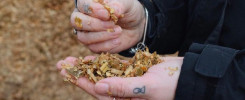What kind of impact does silage have on health and fertility? It may well be the most important factor. There are the obvious risks from moulds, both the kind that grows with the crop in the fields, and most worryingly, the ones that grow in the ensiled crop during storage. Yeast and moulds are the great wasters of the dry matter and nutrition quality of the silage.
Moulds are a danger to you and your family’s health, so why is it so widely accepted in a cow’s intake? The range of harms for livestock includes depressed intakes, poor productivity, depressed immunity, reduced conception, increased embryonic death, and increased abortion rates. Always bear in mind that many of the problems associated with mycotoxins (by-products of moulds) are driven by poor compaction and subsequent oxygen penetration during storage. The top few feet of a silage clamp are never as densely packed as the bottom because silage is “springy” and once oxygen moves into that layer, the heating that comes with yeast growth, not only triggers the moulds, it frequently involves specific yeasts that can reduce lactic acid and raise pH, thereby opening the silage to further problems from other pathogens normally suppressed by low pH.
SiloSolve FC contains two unique strains of bacteria: the patented oxygen scavenger Lactococcus lactis (O-224) and Lactobacillus buchneri (LB1819). These strains are individual to the SiloSolve range and not available in any other inoculant. SiloSolve represents a very new way of conserving forage; containing Oxycap©️Technology — the key to this new way of preserving silage is the microbial removal of oxygen from the clamp; L. lactis (O-224) rapidly removes oxygen from the clamp, a process that takes a matter of hours! The silage fermentation is stabilised very quickly, without heat, with a low level of lactic acid and the oxygen removal makes sure that the spoilage organisms, yeasts and moulds, are strongly inhibited.
What does your silage analysis tell you about protein breakdown and the consequent nasty by-products? The result of protein in silage being broken down by various classes of bacteria, although shown on a silage analysis in ammonia levels, is not measured via analysis by its detrimental byproducts called biogenic amines – resulting in bad smell and therefore bad taste to cows. Cows have 15-18 times the smell receptors of humans, so if the silage doesn’t smell good – intakes will drop!
There’s a range of problems associated with ingesting these byproducts, including diarrhoea and ruminal acidosis. For example in severe cases, histamine toxicity can occur, which can cause a range of symptoms, including inflammation (which may have a role in feet problems), and further effects on fertility.
Having both mycotoxin and biogenic amines in the ensiled crops is easily avoided — good management, and the use of effective control methods at the beginning of the silage process eliminate the need for hugely expensive consequences and solutions at feed-out. Although lactic acid is an important part of silage fermentation, making too much (at the expense of silage sugar content) can lead to increased difficulties at exposure as lactic acid is a feed source for yeast and moulds, and it can also have a negative impact on rumen pH.
The second bacteria in SiloSolve FC, L. buchneri (LB1819), produces acetic acid to inhibit remaining yeasts and moulds, protecting the feed value in the forage, meaning more energy and protein available for milk or meat production. The combined effects from the two bacteria mean that the silage rapidly stabilises and the clamp can be opened and fed in just 7 days.
Silage – the largest component of a cow’s diet – needs to be as healthy and nutritious as possible for a cow to truly reflect that in her own health. SiloSolve not only protects your clamp from moulds and yeasts, puts the brakes on protein-destroying organisms, and enhances fibre digestion, but it retains that precious feed value that gives your cow all she needs to give back in milk. Making better smelling, better tasting and healthier silage.


